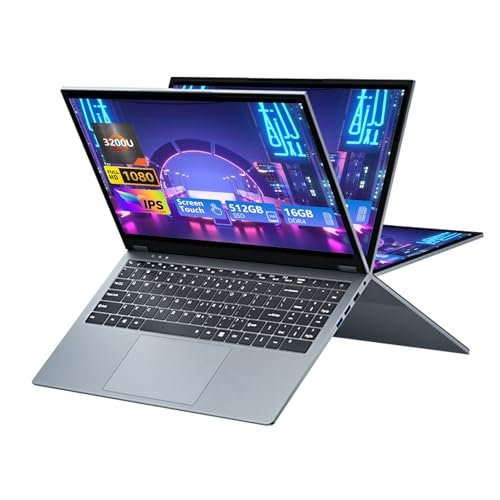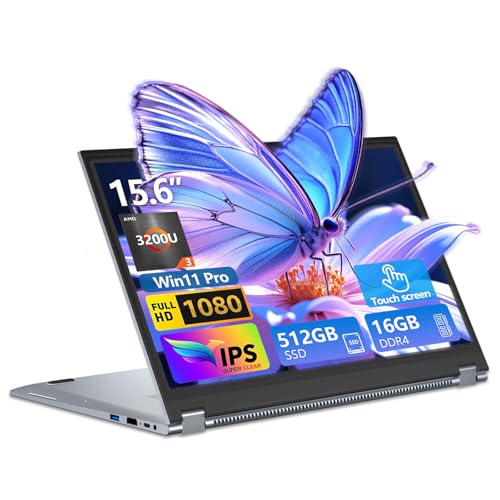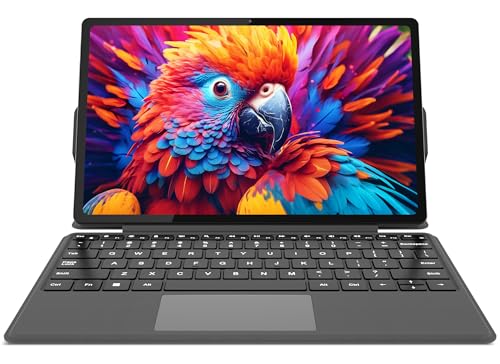For a long time, I struggled with the limitations of a traditional laptop, constantly finding myself in situations where a more versatile device would have made a world of difference. Whether it was needing to quickly jot down notes during a client meeting, share a presentation across a table, or simply enjoy media more comfortably on the go, a rigid clamshell design felt increasingly restrictive. This growing frustration was the initial problem that pushed me to seriously consider a new kind of computing device. Without a solution, I faced continued inefficiencies in my workflow and a less adaptive digital experience, which in today’s fast-paced environment, just wouldn’t cut it.
Key Considerations Before Investing in a Convertible Laptop
A convertible laptop, also known as a 2-in-1, solves the fundamental problem of needing both the productivity of a laptop and the flexibility of a tablet in one device. People typically seek to buy an item in this category when their work or lifestyle demands adaptability – from content consumption to creation, and from on-the-go presentations to comfortable e-reading.
The ideal customer for a convertible laptop is someone who values portability and versatility. This includes students who need to switch between typing essays and taking handwritten notes, professionals who frequently present or collaborate in varied settings, and even casual users who want a device that can easily transition from work to entertainment. They are often looking for a balance between performance, battery life, and form factor.
However, a 2-in-1 laptop might not be for someone who primarily needs raw processing power for intensive tasks like high-end gaming, video editing, or complex CAD work; such users would likely benefit more from a dedicated, more powerful traditional laptop or desktop workstation. Similarly, if your main need is a simple tablet for basic browsing and media, a lower-cost standalone tablet might suffice.
Before buying, one should consider:
* Intended Use: Will you primarily use it for productivity, media, or both?
* Performance Needs: What applications will you run? Do you need a powerful processor and ample RAM?
* Screen Size and Resolution: How important is screen real estate versus portability?
* Battery Life: How long do you need it to last on a single charge?
* Portability: How often will you carry it, and does weight/size matter?
* Build Quality and Durability: Especially for renewed devices, how robust is the construction?
* Ports and Connectivity: Do you need specific ports like USB-A, HDMI, or an SD card slot?
* Budget: Renewed options can offer great value, but inspect their grading.
- 【2 in 1 Powerful Laptop】The touch screen laptop adopts Ryzen3 3200U processor up to 3.5GHZ, whether it is multitasking or running large software, it...
- Powerful AMD Performance: 2 in 1 laptop equipped with an AMD Ryzen 3 3200U processor (up to 3.5GHz) and AMD Radeon Graphics, this AMD laptop computer...
- 【2-in-1 Tablet & Laptop】Combining the mobility of a tablet with the power of a laptop, this 2-in-1 device features a detachable magnetic leather case...
Introducing the Dell Latitude 3189
The Dell Latitude 3189 is a compact, 11.6-inch convertible 2-in-1 laptop designed for flexibility and everyday productivity, especially in educational or business environments where durability and adaptability are key. It promises a seamless transition between laptop and tablet modes, powered by a capable Intel Pentium N4200 processor, 8GB of memory, and a swift 128GB SSD, all running on Windows 10 Pro. When purchased as a renewed unit, it typically comes with the laptop itself and a power adapter. Compared to market leaders in the premium 2-in-1 space, the Latitude 3189 offers a more budget-friendly entry point, prioritizing practical functionality over high-end aesthetics or cutting-edge performance. Its previous versions were less robust or versatile, making this model a notable improvement in its niche.
This specific Dell Latitude 3189 is ideally suited for students, educators, small business professionals, or anyone seeking a portable, versatile, and cost-effective computing solution for daily tasks. It’s also excellent for those who appreciate the robust, business-oriented build of the Latitude series. However, it’s not for power users needing a dedicated graphics card, extensive storage for large media libraries, or blistering CPU performance for demanding software.
Pros:
* Versatile 2-in-1 Design: Easily switches between laptop, tent, stand, and tablet modes.
* Compact & Portable: 11.6-inch form factor and relatively light weight make it highly portable.
* Responsive Touchscreen: Offers intuitive interaction, great for note-taking and navigation.
* SSD Storage: Provides a fast and smooth computing experience for everyday tasks.
* Windows 10 Pro: Offers enhanced security and business features.
Cons:
* Pentium Processor: While adequate for basic tasks, it may feel slow for heavy multitasking or resource-intensive applications.
* “B Grade” Condition (for renewed units): May come with cosmetic imperfections like dents, scuffs, or screen scratches.
* Hinge Durability Concerns: Some users have reported issues with hinges over time, especially with frequent 2-in-1 use.
* Battery Life Consistency: Can vary, and older refurbished batteries might not hold a charge as long as new.
* Limited Storage: 128GB SSD might be restrictive for users with large files or many applications.
Deep Dive: Exploring the Features and Advantages
Convertible 2-in-1 Design and Build Quality
The standout feature of the Dell Latitude 3189 is undoubtedly its convertible 2-in-1 design. Having used it for various tasks, I can attest to how seamlessly it transitions between modes. In laptop mode, it’s a perfectly functional, compact notebook for typing documents or emails. But when I need to collaborate on a project, flipping it into tent or stand mode is incredibly useful for sharing the screen with colleagues. For quick note-taking during meetings or browsing articles on the couch, folding it completely into tablet mode feels surprisingly natural, transforming the device into a large, interactive slate.
This adaptability is important because it truly caters to a dynamic workflow. No longer am I confined to one way of interacting with my device. This versatility directly addresses the core problem of rigidity I faced before, allowing me to adapt my computing experience to the situation at hand. However, it’s important to acknowledge the “B grade” nature of these renewed units; while my experience has been largely positive, some units may show signs of wear, like minor dents or scuffs. This is a trade-off for the renewed pricing, but Dell’s Latitude series is generally built to be robust, making it suitable for active use, even in a renewed state.
Display Quality and Touchscreen Responsiveness
The 11.6-inch HD LED-backlit IPS display with a 1366 x 768 resolution might not be 1080p, but for its size and intended use, it’s surprisingly crisp and clear. The IPS panel offers decent viewing angles, which is crucial for a touchscreen laptop that will be viewed from various angles in different modes. More importantly, the touchscreen is highly responsive. I’ve found it to be very accurate, whether I’m navigating through menus, sketching quick diagrams, or simply scrolling through web pages. There’s minimal lag, making the touch interaction smooth and intuitive.
The responsiveness of the touchscreen is a significant benefit, especially when using the device in tablet mode. It enhances productivity for tasks like annotating PDFs or drawing, and it greatly improves the overall user experience for casual browsing or media consumption. The clarity, even at 720p resolution, is sufficient for most everyday tasks, providing a pleasant visual experience without putting excessive strain on the integrated graphics.
Performance: Processor, Memory, and Storage
Under the hood, the Dell Latitude 3189 is equipped with an Intel Pentium N4200 processor, 8GB of DDR3 memory, and a 128GB eMMC SSD. Now, let’s be clear: this isn’t a powerhouse machine built for heavy-duty gaming or professional video editing. However, for its target audience and price point, the performance is remarkably snappy for everyday tasks. The Pentium N4200, a quad-core processor, handles web browsing with multiple tabs, word processing, spreadsheets, and video streaming without breaking a sweat.
The 8GB of RAM is a crucial component here, allowing for much smoother multitasking compared to systems with only 4GB. You can comfortably switch between applications without experiencing significant slowdowns. The 128GB eMMC SSD is the unsung hero, however. It significantly cuts down boot times and application loading times compared to traditional hard drives, making the overall computing experience feel incredibly fast and responsive. This speed directly addresses the problem of sluggish performance often associated with budget-friendly laptops, ensuring that daily operations are efficient and frustration-free. While 128GB might seem limited for storage, for cloud-reliant users or those who don’t store large media libraries locally, it’s perfectly adequate and contributes to the device’s overall speed.
Portability and Connectivity
Weighing in at approximately 3.2 pounds (1.45 kg) and with an 11.6-inch screen, the Latitude 3189 is designed with portability in mind. It slips easily into most bags and doesn’t feel like a burden to carry around all day. This lightweight design makes it an excellent companion for students moving between classes or professionals who commute frequently. Its compact size ensures it can be used comfortably in tight spaces, like airplane trays or crowded cafes.
In terms of connectivity, the Dell Latitude 3189 offers a practical selection of ports. It features two USB ports, with at least one being USB 3.0, which boasts transmission speeds up to 10 times faster than USB 2.0. This is great for quickly transferring files from external drives or connecting modern peripherals. There’s also an HDMI port, which is invaluable for connecting to external monitors or projectors for presentations. A headphone/microphone combo jack ensures you can easily connect audio devices, and a MicroSD card slot adds convenient expandable storage. The placement of these ports is ergonomic and accessible, which is a small but appreciated detail in daily use. Bluetooth support is also included, allowing for seamless connection to wireless headphones, mice, and other accessories.
Operating System and User Experience
Running on Windows 10 Pro 64-bit, the Dell Latitude 3189 comes with a robust and familiar operating system. Windows 10 Pro provides enhanced security features like BitLocker encryption and Group Policy management, which are particularly beneficial for business or educational environments. For the average user, it simply means a stable, well-supported platform with access to a vast ecosystem of applications.
The overall user experience is positive, especially considering it’s a renewed device. The integration of the touchscreen with Windows 10’s tablet mode works well, making navigation intuitive whether you’re using the keyboard and touchpad or your fingers. The QWERTY keyboard, while compact, is comfortable for typing, and the inclusion of a backlit keyboard (as per specifications, though some renewed units might vary) is a definite plus for working in dimly lit environments. The touchpad is responsive and supports multi-touch gestures, further enhancing ease of use.
Potential Drawbacks of a Renewed Unit
As with any renewed product, there are inherent trade-offs. While my experience has been largely positive, it’s essential to set realistic expectations. The “B grade” designation means cosmetic imperfections such as minor dents, chips, scuffs on the body, hairline scratches on the screen, or a slightly shiny/worn keyboard are possible. These are typically cosmetic and don’t affect functionality, but they are worth noting if aesthetics are a primary concern.
A more significant potential issue highlighted by some users is the durability of the hinges, which, despite the Latitude line’s reputation for robustness, can be a point of failure over extended use, especially with frequent conversions between modes. Additionally, while the battery life is decent, a renewed unit’s battery may not perform as well as a brand-new one, and individual experiences can vary. In my case, an initial issue with a faulty power adapter on a renewed unit meant I had to use a spare to get going, which was a minor inconvenience. These points underscore the importance of buying from reputable renewed sellers and understanding their return policies.
What Others Are Saying: Real User Experiences
Having explored the internet for feedback, it’s clear that many users have had positive experiences with the Dell Latitude 3189, especially as a renewed product. Many express pleasant surprise at receiving a device that looks almost new, with minimal cosmetic blemishes that are hardly noticeable. People frequently praise its performance for everyday tasks, describing it as “working like a charm” for browsing, writing, and online meetings. The compact size, touch screen responsiveness, and decent battery life are often highlighted as significant advantages, offering great value for the money. However, a recurring concern for some pertains to the hinges on renewed units, with a few individuals experiencing durability issues and stripped screw holes, suggesting that quality control on some refurbished models can be inconsistent. Additionally, while generally praised, some users noted the webcam can sometimes cast a yellow tint, or that the overall speed, while good for basics, isn’t blazing fast.
Concluding Insights: Is the Dell Latitude 3189 Your Next Device?
The problem of needing a versatile, portable, and cost-effective computing solution is more relevant than ever. Without such a device, you might find yourself constantly switching between a laptop and a tablet, or simply missing out on the flexibility required for modern work, study, or leisure. The complications range from inefficiency in presentations to an inability to comfortably consume media on the go, hindering your digital adaptability.
The Dell Latitude 3189 stands out as a great fit to solve this problem for several key reasons. Firstly, its 2-in-1 convertible design offers unparalleled versatility, allowing you to seamlessly transition between laptop, tablet, and presentation modes. Secondly, despite being a renewed unit, its combination of an Intel Pentium N4200 processor, 8GB RAM, and a 128GB SSD ensures a smooth and responsive experience for most daily tasks. Finally, the practical port selection, sturdy build (even as a B-grade renewed unit), and Windows 10 Pro operating system make it a reliable and secure choice for students, professionals, and casual users alike. If you’re looking for a dependable and adaptable device without breaking the bank, this renewed laptop is an excellent option. To learn more and check it out, click here!
Last update on 2025-11-23 / Affiliate links / Images from Amazon Product Advertising API



